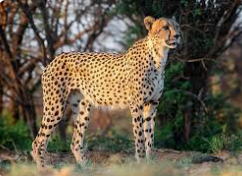
Baby cheetahs are being torn away
from their mothers in Kenya and sold
in Somalia for just about Sh10,000.
The smugglers then whisk them through dusty roads in Somalia and via small boat to Yemen, from where they are sold to wealthy Arabian buyers for as high as Sh3.8 million a cub.
This is according to a new study, which traces the possible routes the cubs are taken through, under cover of darkness, until they reach their new prison mansions in Kuwait, Qatar, Saudi Arabia, United Arab Emirates and Yemen.
Pet cheetahs are in high demand in these countries, where they are considered symbols of wealth and prestige for their owners.
“These economic incentives and the limited enforcement to combat the illegal trade continue to drive the capture and theft of cheetah cubs from East Africa to the Arabian Peninsula,” the study reports.
Cheetahs are friendly and docile compared to other wild cats. The study, published last week in Conservation Biology, highlights a crisis for East Africa’s cheetah population.
Only an estimated 6,500 adult and adolescent cheetahs remain in Africa, inhabiting a mere 13 per cent of their historical range.
Kenya is the main stronghold for the East African cheetah, with the largest population of 800 to 1,200 adults in the country since 2015.
They live primarily outside protected national parks and reserves. Approximately 80 per cent of Kenya’s cheetahs live on public and community land.
“The illegal trade of live cubs as pets in the Arabian Peninsula has the most significant impact on cheetah populations in the Horn of Africa,” notes the study, titled “Mapping illegal trade routes of live cheetahs from the Horn of Africa to the Arabian Peninsula.”
Kenya Wildlife Service did not immediately respond to a request for comment from the Star. Led by Paul Evangelista from Colorado State University, the study traces trafficking routes across East Africa and underscores the significant threat posed to one of the world’s fastest land animals, already struggling due to habitat loss and human-wildlife conflicts.
Transporting the cubs is perilous, often resulting in high mortality rates. Traffickers transport the young animals across land and sea in cramped conditions, usually on small boats across the Gulf of Aden.
“Cheetah cubs taken from their mothers endure gruelling journeys,” the study notes.
They are often hidden in squalid markets or private homes until buyers in Gulf countries arrange final transactions.
The cubs’ survival rates are low and many die from malnutrition, inadequate care and high stress levels, underscoring the cruelty of the trade and its toll on the animals’ health and well-being. Traffickers, motivated by the high profit margins, are undeterred by the minimal penalties if they are caught.
The study documents an alarming surge in trafficking, with over 1,880 instances of seizures or attempted sales of live cheetahs and parts from 2010 to 2019 alone.
Of these, 91 per cent involved live
cheetahs, primarily cubs, with 95
per cent of these originating in the
Horn of Africa and destined for pet
markets in the Arabian Peninsula.






![[PHOTOS] Guardian Angel bus catches fire in Kikuyu](/_next/image?url=https%3A%2F%2Fcdn.radioafrica.digital%2Fimage%2F2025%2F04%2F58287f0a-f201-4a78-87f0-6f147ad8ba8a.jpg&w=3840&q=100)




